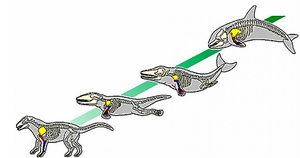Evolution of Dolphins: Difference between revisions
| Line 6: | Line 6: | ||
Over the 50 million years of evolution, the ancestors of dolphins adapted from being terrestrial to aquatic. A characteristic that is mainly found in terrestrial animals is that of a vertical spine. Dolphins have vertical spines leaving them swimming with vertical movements, while fish movements are horizontal.<ref>[https://www.dolphins-world.com/dolphin-evolution/ Dolphins-World, “Dolphin Evolution”, April 25, 2017. Dolphins-World]</ref> In comparison to the <i>Pakiectus</i>, dolphins hav much larger skulls with a shape that has adapted to accommodate for a padded lower jaw and extended middle ear. Having an extended middle ear allows the dolphins to use echolocation for communication. As the ancestors of dolphins moved toward living aquatically, the nostrils evolved into a blowhole to expend less energy while surfacing to breathe. The ancestors of dolphins that lived terrestrially had legs to walk. Dolphins have two small pelvic bones that are rod shaped that are now vestigial legs from their land walking ancestors.<ref>[https://www.dolphins-world.com/dolphin-evolution/ Dolphins-World, “Dolphin Evolution”, April 25, 2017. Dolphins-World]</ref> | Over the 50 million years of evolution, the ancestors of dolphins adapted from being terrestrial to aquatic. A characteristic that is mainly found in terrestrial animals is that of a vertical spine. Dolphins have vertical spines leaving them swimming with vertical movements, while fish movements are horizontal.<ref>[https://www.dolphins-world.com/dolphin-evolution/ Dolphins-World, “Dolphin Evolution”, April 25, 2017. Dolphins-World]</ref> In comparison to the <i>Pakiectus</i>, dolphins hav much larger skulls with a shape that has adapted to accommodate for a padded lower jaw and extended middle ear. Having an extended middle ear allows the dolphins to use echolocation for communication. As the ancestors of dolphins moved toward living aquatically, the nostrils evolved into a blowhole to expend less energy while surfacing to breathe. The ancestors of dolphins that lived terrestrially had legs to walk. Dolphins have two small pelvic bones that are rod shaped that are now vestigial legs from their land walking ancestors.<ref>[https://www.dolphins-world.com/dolphin-evolution/ Dolphins-World, “Dolphin Evolution”, April 25, 2017. Dolphins-World]</ref> | ||
==Genetics== | ==Adaptation Genetics== | ||
[[Image:Body.jpeg|thumb|300px|left|To adapt to living in an aquatic environment, the dolphins what to change their body and way of living. Throughout millions of years of evolution, the dolphin body form changed from the walking mammal with four limbs, <i>Pakicetus</i>, to the swimming mammal with flippers and a tail, <i>Delphinus</i>. https://dolphin-academy.com/learn/evolution]] | [[Image:Body.jpeg|thumb|300px|left|To adapt to living in an aquatic environment, the dolphins what to change their body and way of living. Throughout millions of years of evolution, the dolphin body form changed from the walking mammal with four limbs, <i>Pakicetus</i>, to the swimming mammal with flippers and a tail, <i>Delphinus</i>. https://dolphin-academy.com/learn/evolution]] | ||
The common dolphins underwent centuries of evolution to move from terrestrial to aquatic mammals. These mammals share much of their evolution with the other members of the <i>Cetacea</i>. Various genes went through positive selection, or Darwinian selection, to be in the form they take today. Numerous studies show the about 2.26%-4.8%, around 376 genes, of genes were selected for with positive selection. This gene selection is believed to help the overall system development, pattern of specification process, and mesoderm development.<ref>https://www.ncbi.nlm.nih.gov/pmc/articles/PMC3686761/ Mariana F. Nery, Dimar J. Gonzalez, and Juan C. Opazo, “How to Make a Dolphin: Molecular Signature of Positive Selection of Cetacean Genome” 2013. National Center for Biotechnology Information</ref> | |||
==Section 2 Microbiome== | ==Section 2 Microbiome== | ||
Revision as of 01:40, 4 December 2019
Introduction

The evolution of dolphins, or Delphinus, is believed to have started with the Pakiectus a four legged, land walking mammal. The Pakiectus dates back to approximately 50 million years ago. Throughout the centuries, these animals have gone through drastic changes to become the modern day dolphin. Along with the Pakiectus, the dolphin is thought to have evolved alongside or from the Ambulocetus, Remingtonocetidae, Protocetid, Basilosaurudae, Dorudontid, Squalodontidae, Aetiocetidae, and Kentriodontidae to eventually become the Delphinus which is found in the Cetacea infraorder.[1][2] The Pakiectus lived near the shallow waters and began to feed on organisms that lived in these waters, which began the transition from terrestrial to aquatic animals. The bone structure of the flipper in the modern dolphin is very similar to the structure found in the Pakiectus legs and hooves, confirming the link between the two organisms.[3]
Over the 50 million years of evolution, the ancestors of dolphins adapted from being terrestrial to aquatic. A characteristic that is mainly found in terrestrial animals is that of a vertical spine. Dolphins have vertical spines leaving them swimming with vertical movements, while fish movements are horizontal.[4] In comparison to the Pakiectus, dolphins hav much larger skulls with a shape that has adapted to accommodate for a padded lower jaw and extended middle ear. Having an extended middle ear allows the dolphins to use echolocation for communication. As the ancestors of dolphins moved toward living aquatically, the nostrils evolved into a blowhole to expend less energy while surfacing to breathe. The ancestors of dolphins that lived terrestrially had legs to walk. Dolphins have two small pelvic bones that are rod shaped that are now vestigial legs from their land walking ancestors.[5]
Adaptation Genetics

The common dolphins underwent centuries of evolution to move from terrestrial to aquatic mammals. These mammals share much of their evolution with the other members of the Cetacea. Various genes went through positive selection, or Darwinian selection, to be in the form they take today. Numerous studies show the about 2.26%-4.8%, around 376 genes, of genes were selected for with positive selection. This gene selection is believed to help the overall system development, pattern of specification process, and mesoderm development.[6]
Section 2 Microbiome
Include some current research, with a second image.
Conclusion
Overall text length should be at least 1,000 words (before counting references), with at least 2 images. Include at least 5 references under Reference section.
References
- ↑ Bapor Kibra, Willemstad, Curaçao, “Learn About Dolphin Evolution” 2019. Dolphin Academy
- ↑ Mark Caney, “Evolution of Dolphins” 2019. Dolphin Way
- ↑ Dolphins-World, “Dolphin Evolution”, April 25, 2017. Dolphins-World
- ↑ Dolphins-World, “Dolphin Evolution”, April 25, 2017. Dolphins-World
- ↑ Dolphins-World, “Dolphin Evolution”, April 25, 2017. Dolphins-World
- ↑ https://www.ncbi.nlm.nih.gov/pmc/articles/PMC3686761/ Mariana F. Nery, Dimar J. Gonzalez, and Juan C. Opazo, “How to Make a Dolphin: Molecular Signature of Positive Selection of Cetacean Genome” 2013. National Center for Biotechnology Information
Edited by [Carolyn Herbosa], student of Joan Slonczewski for BIOL 116 Information in Living Systems, 2019, Kenyon College.
